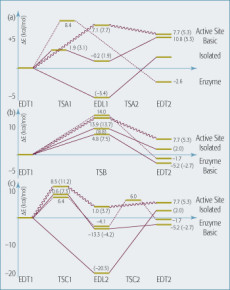QM/MM Studies of the Triosephosphate Isomerase-Catalyzed Reaction
December 31, 2002
NERSC Annual Report 2002
Triosephosphate isomerase (TIM) is a dimeric enzyme that catalyzes the conversion between dihydroxyacetone phosphate (DHAP) and R-glyceraldehyde 3-phosphate (GAP), which is an important step in glycolysis (the enzymatic breakdown of carbohydrates). TIM increases the reaction rate by more than109 times, and has thus been referred to as a “perfect” enzyme.
Many experimental techniques have been used to study the enzyme, supplemented by a number of theoretical calculations, but the complex catalytic mechanisms are not yet fully understood. However, detailed calculations by Cui and Karplus are providing a wealth of information and bringing us closer to a complete solution.
Three possible mechanisms for the second step of TIM-catalyzed reactions, which involves a proton transfer, have been studied by the combined quantum mechanical/molecular mechanical (QM/MM) approach at a number of QM levels. Cui and Karplus compared the various QM levels to verify the adequacy of their recent MM analysis of the reaction mechanism, which ruled out one of the proposed pathways. The relative contributions from the two other proposed pathways, however, are difficult to determine at the present level of theory, and both pathways are consistent with available experiments.
Density functional calculations were conducted for model systems in the gas phase and in solution, and selected models were also studied with ab initio calculations. The QM model calculations in solution and a QM/MM perturbation analysis showed that a number of factors combine to yield the factor of 109 reaction rate enhancement by TIM. These include orienting catalytic groups in good positions for the proton transfers, employing charged and polar groups that stabilize the reaction intermediates, and permitting flexibility of the catalytic groups.
Some residues far from the active site as well as certain water molecules also make significant contributions. For the electrostatic interaction and polarization to function effectively, the active site of TIM has a relatively low effective dielectric constant, which reflects the structural integrity of the enzyme active site as compared with solution. Short hydrogen bonds occur during the reaction, but the calculated energetics indicate that they do not have a specific role in catalysis.
Investigators
M. Karplus and Q. Cui, Harvard University.
Publication
Q. Cui and M. Karplus, “Quantum mechanical/molecular mechanical studies of the triosephosphate isomerase-catalyzed reaction: Verification of methodology and analysis of reaction mechanisms,” J. Phys. Chem. B 106, 1768 (2002).
About NERSC and Berkeley Lab
The National Energy Research Scientific Computing Center (NERSC) is a U.S. Department of Energy Office of Science User Facility that serves as the primary high performance computing center for scientific research sponsored by the Office of Science. Located at Lawrence Berkeley National Laboratory, NERSC serves almost 10,000 scientists at national laboratories and universities researching a wide range of problems in climate, fusion energy, materials science, physics, chemistry, computational biology, and other disciplines. Berkeley Lab is a DOE national laboratory located in Berkeley, California. It conducts unclassified scientific research and is managed by the University of California for the U.S. Department of Energy. »Learn more about computing sciences at Berkeley Lab.








